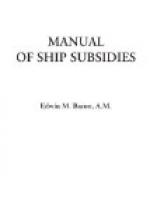The report of the commission was submitted to the Fifty-eighth Congress, third session, January 4, 1905.[HW] No action was had on the bill in that Congress. It was referred to the committee on commerce; reported back to the Senate with sundry amendments and a minority report against it;[HX] was debated tentatively; and finally passed over at the request of its sponsor, Senator Gallinger, who expressed himself as satisfied that the bill could not receive the consideration it deserved at that session. Meanwhile both Houses had directed a continuance of the commission’s inquiry. In May the chairman, Senator Gallinger, held conferences in New York with several representatives of the shipping interests who had not been heard; and later sessions were held in Washington, at which other statements were received and considered.
At the opening of the Fifty-ninth Congress, December 4, 1905, Senator Gallinger submitted a supplementary report of the commission, and with it introduced a new bill—the previous bill in a new draft.[HY] At the same time Representative Charles H. Grosvenor, of Ohio, the first House member of the commission, introduced the bill to the House.
This draft added several new features to the original bill. The most important were provisions for increasing the subsidies payable under the law of 1891 to the single American contract line to Europe, and to the Oceanic Line from San Francisco to Auckland and Sydney. These provisions added two hundred and fifty thousand dollars to the former’s subsidy of seven hundred and fifty thousand, and two hundred and seventeen thousand to the latter’s of two hundred and eighty-three thousand. The reasons given for these increases were: in the case of the American Line, because this line “meets the fiercest competition of the State-aided corporations of Europe, soon to be intensified by the new subvention of one million one hundred thousand dollars granted to the Cunard Company by the British Government, on terms so liberal as to make it equivalent to one and a half million dollars a year”; and in the case of the Australasia Line, because it “operates in Pacific waters where cost of fuel, labor, etc., is considerably greater than at Atlantic ports; ... is required to maintain a very high speed; ... employs exclusively white crews instead of the Asiatics utilized by many other Pacific companies.” Another provision, as a special encouragement for American shipowners to enter the Philippine trade, added a subvention of thirty per cent above the regular rate, or six and a half dollars a ton. The naval volunteer retainers were extended to seamen of the Great Lakes and coastwise trade.[HZ]




